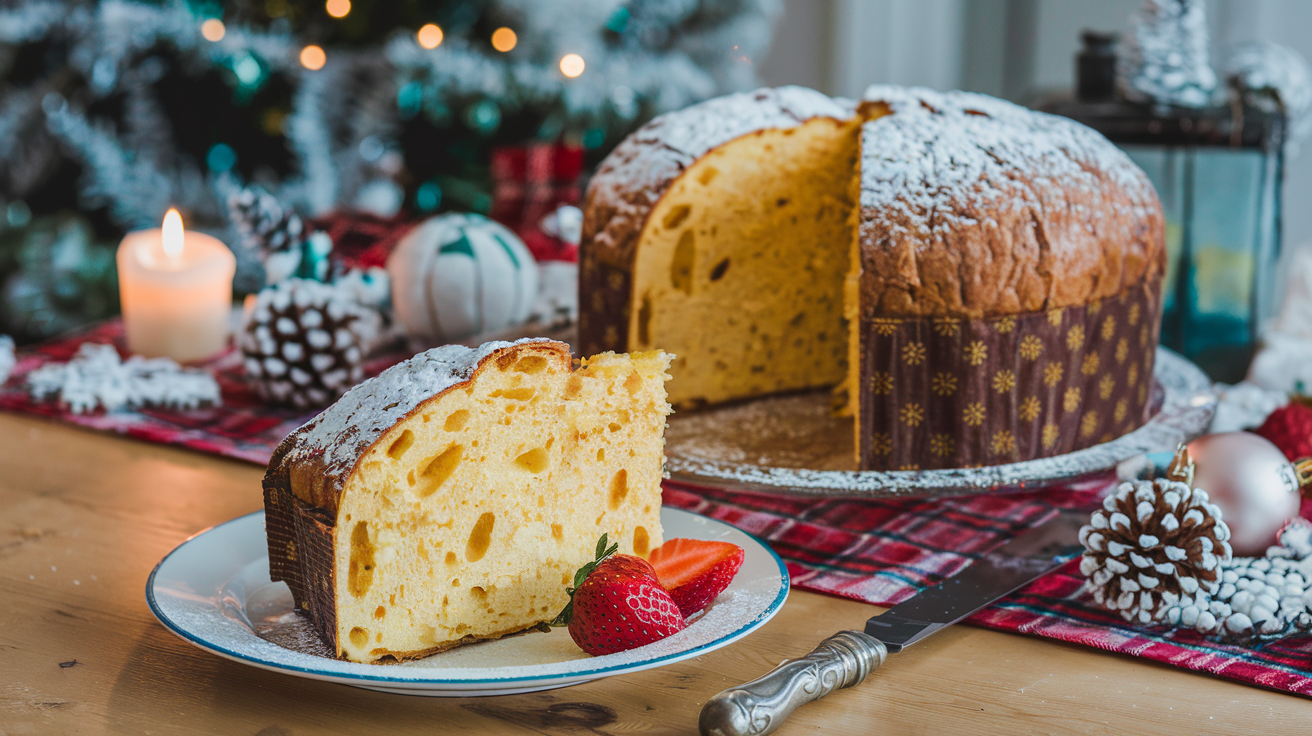Nothing embodies the warmth of the holidays quite like Panettone, the classic Italian Christmas bread. Imagine the soft texture, the buttery aroma, and the delightful pops of candied fruits and raisins in every bite. Whether you’re savoring it with morning coffee or gifting it to loved ones, Panettone is more than a treat—it’s a cherished tradition. Ready to bring this iconic dessert into your kitchen? Let’s dive into everything you need to know to create a showstopping Panettone at home.
Table of Contents
What is Panettone? A Brief History
Panettone is no ordinary bread. Originating from Milan in the 15th century, it began as a humble loaf before evolving into the luxurious, fruit-studded dessert we know today. Traditionally baked during Christmas, it symbolizes celebration and abundance. Over the centuries, Panettone has traveled beyond Italy, becoming a beloved holiday staple worldwide. Its airy texture and rich flavor make it a standout on any festive table, and now, you can create this masterpiece in your own kitchen.
Ingredients for a Classic Panettone Recipe
The secret to a perfect Panettone lies in the quality of your ingredients. Here’s what you’ll need:
| Ingredient | Quantity | Notes |
|---|---|---|
| All-purpose flour | 500g | Use high-protein flour for structure. |
| Granulated sugar | 120g | Provides sweetness and color. |
| Unsalted butter | 150g | Room temperature for easy mixing. |
| Eggs | 3 large | Adds richness and binds the dough. |
| Milk | 120ml | Warm but not hot for yeast activation. |
| Yeast | 10g | Dry active or fresh works well. |
| Salt | 1 tsp | Enhances flavor balance. |
| Candied orange peel | 100g | Traditional and aromatic. |
| Raisins | 150g | Soak for a plump texture. |
| Vanilla extract | 1 tsp | Adds depth to the flavor. |
Step-by-Step Panettone Recipe
Preparing the Dough
- Activate the yeast: Combine warm milk with yeast and a pinch of sugar. Allow it to foam for about 5 minutes.
- Mix dry ingredients: In a large bowl, sift flour, sugar, and salt together. This ensures even distribution.
- Combine wet ingredients: Beat eggs, softened butter, and vanilla extract in a separate bowl until smooth.
- Knead the dough: Gradually mix wet ingredients into the dry mixture. Knead by hand or with a stand mixer until the dough is smooth and elastic.
Incorporating the Fruits
- Fold in the soaked raisins and candied orange peel, ensuring even distribution throughout the dough.
Proofing and Shaping
- First rise: Cover the dough with a clean cloth and let it double in size in a warm place (approximately 2 hours).
- Shape the dough: Gently deflate and shape it into a round loaf. Place it in a Panettone mold or a high-sided cake tin.
- Second rise: Allow the dough to rise again for 1-2 hours until it fills the mold.
Baking the Panettone
- Preheat your oven to 180°C (350°F).
- Bake for 35-40 minutes, ensuring the top is golden brown. If it browns too quickly, cover loosely with foil.
- Cool upside-down (using skewers) to maintain its signature dome shape.
Tips for Success: Mastering Panettone at Home
- Use quality ingredients: High-protein flour and fresh yeast make a noticeable difference.
- Invest in proper equipment: A stand mixer simplifies kneading, especially for this sticky dough.
- Be patient: Proofing times are essential for achieving Panettone’s airy texture.
- Avoid overloading fruits: Too much can weigh down the dough.
- Cool it properly: Cooling upside-down ensures your Panettone retains its structure.
Perfecting the Panettone Recipe: A Sweet Slice of Italian TraditionOriginating from Milan in the 15th century, Panettone has evolved into the luxurious, fruit-studded dessert we know today. Traditionally baked during Christmas, it symbolizes celebration and abundance. Now you can create this masterpiece in your own kitchen with our step-by-step recipe and expert tips for success.
Variations and Creative Twists
While the classic recipe is delightful, adding your own spin can make it even more special.
Flavor Variations
- Chocolate Chip Panettone: Swap candied fruits for chocolate chips for a rich twist.
- Nutty Delight: Incorporate chopped hazelnuts or almonds for a crunchy texture.
- Citrus Bliss: Enhance with lemon zest and dried cranberries.
Dietary Adaptations
- Gluten-Free Panettone: Substitute with gluten-free flour blends and adjust liquid ratios.
- Vegan Panettone: Use plant-based butter, almond milk, and flaxseed eggs as substitutes.
Frequently Asked Questions (FAQs)
Why is my Panettone not rising properly?
Ensure your yeast is fresh and the milk is warm, not hot, as extreme temperatures can kill yeast.
Can I make Panettone without a mold?
Absolutely! Use a high-sided cake tin or even a clean coffee can lined with parchment paper.
How do I store Panettone?
Wrap it tightly in plastic wrap and store it in an airtight container. It stays fresh for up to a week.
Can I freeze Panettone?
Yes, slice it into portions, wrap each in plastic, and freeze for up to 3 months. Thaw at room temperature or gently warm in the oven.
Conclusion: Bring the Warmth of Italy to Your Kitchen
Creating a Panettone from scratch may seem daunting, but with the right recipe and a bit of patience, you can master this beloved Italian tradition. Whether you stick to the classic version or experiment with new flavors, the joy of baking and sharing Panettone is unparalleled. Why wait? Gather your ingredients, roll up your sleeves, and bring the magic of Panettone to life in your kitchen.
Ready to bake your own Panettone? Share your creations or questions in the comments below!

